‘Born in the U.S.A.’ at 40: When Bruce Springsteen ruled the rock world and refused to become the voice of Republicans
The classic record by the Boss became the biggest-selling album in the world in 1985 and paved the way to superstardom and political activism for the New Jersey native
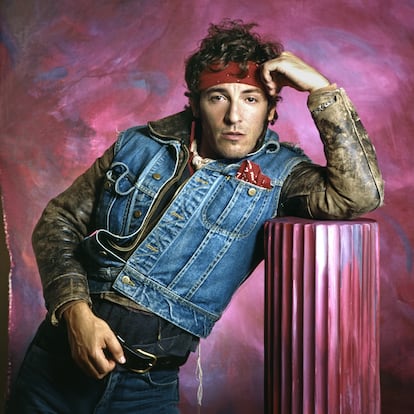
“Born In the U.S.A. changed my life, gave me my biggest audience, forced me to think more about the way I presented my music and briefly put me at the center of the pop world,” Bruce Springsteen wrote in his autobiographical book Born To Run (2016). The Boss’ seventh album, which was released on June 4, 1984, became the biggest-selling album in the world the following year, at the same time as three other American musicians (Michael Jackson, Madonna, and Prince) were vying for the throne of global popular music. That album not only turned the rocker from Freehold, New Jersey, into a superstar, but also imprinted his most iconic image on the memories of a generation: his muscular arms raised, with a red bandana on his head and the American flag behind him.
However, Springsteen has always been ambivalent about Born in the U.S.A. “Curiously, it is the only classic Springsteen album that has not been afforded the retrospective treatment of earlier works such as Born To Run (1975), Darkness On The Edge Of Town (1978) or The River (1980). This shows a certain discomfort with the results, although not so much with the songs themselves, as many of them are still played at his concerts,” explains music critic Ignacio Juliá. The only special edition of that album that will be released, on June 14, is a deluxe vinyl edition but without any extra material.
The truth is that something was changing in Springsteen’s life when he recorded Born in the U.S.A., but perhaps nothing that foreshadowed such a resounding rise to the league of the big stadiums. After the exhausting tour for The River, with 140 concerts throughout 1980 and 1981, he became tired and depressed and began to visit a psychologist, who recommended that he go to the gym. Regular weight training, he said, helped him get his head on straight. In time, he felt pressured to record in New York with his usual backing group, The E Street Band, but the marathon sessions produced material so contrasting that two albums were released.
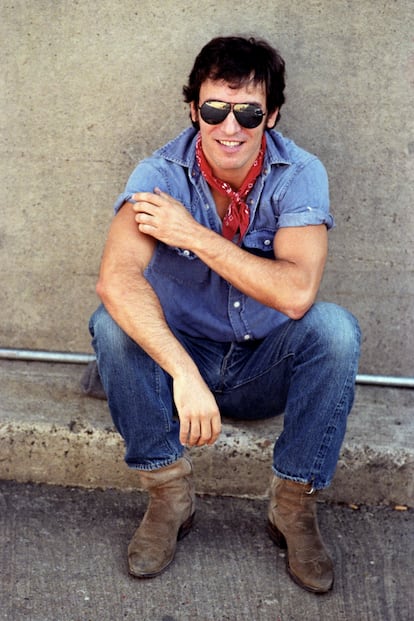
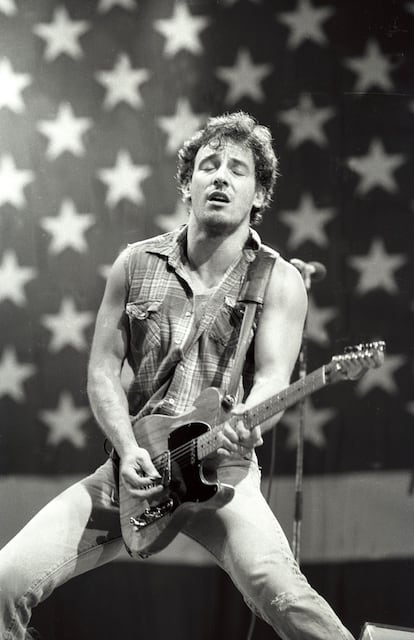
The first of them, Nebraska (1982), was a practically acoustic work, which dealt with dark social themes, and in that same vein emerged many of the songs that would later make up Born in the U.S.A., including the famous title track. Nebraska was the first album that Springsteen did not tour for. Instead, he remained locked in the studio for two years and recorded almost 90 songs. The seventh album was almost ready, but his manager, Jon Landau, told him that it was missing a song that could be a hit. Within days, the musician delivered Dancing in the Dark, the most successful single of his career.
His record label, CBS, took the example of Michael Jackson’s Thriller, from which seven singles were released with their corresponding videos in a new media scenario dominated by MTV and image culture. Seven singles (and five videos) were also released from Born in the U.S.A. The first, Dancing in the Dark, was directed by Brian de Palma and featured Springsteen himself dancing with a then-unknown Courteney Cox. Three of the following videos were directed by another filmmaker who was beginning to emerge, John Sayles. All of them starred the singer, who played the characters he had created for his songs, such as the car mechanic in I’m on Fire or the former baseball player in Glory Days.
To his new iconography had to be added the album cover, with Springsteen, photographed by Annie Leibovitz, with his back to the American flag. The image gave rise to all kinds of theories. A rather curious one was that the musician was urinating on the flag. He himself denied this in an interview with Kurt Loder for Rolling Stone magazine, saying that, when it came down to choosing, the photo of his backside was better than the one of his face.
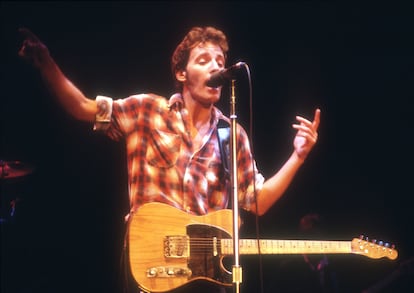
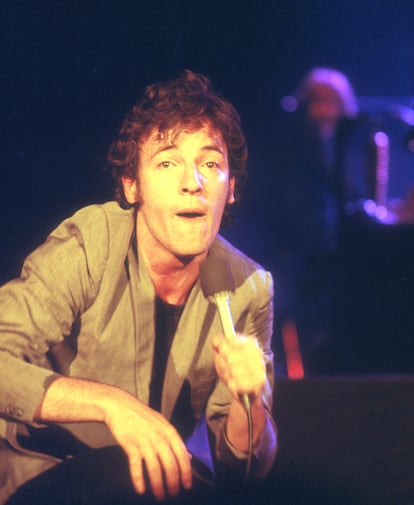
The voice of a generation
The truth is that almost everything that happened with Born in the U.S.A. was sought after by the artist. “I was fascinated by people who had become the voice of their time,” he later acknowledged. “I don’t know if I felt I had the capacity for it or just wanted to move in that direction, but it was something that interested me.” “Born in the U.S.A. is a very important work, the one that culminated the narrative he had been spinning since 1973 for those who had never before stopped to listen to Darkness On The Edge Of Town or Nebraska. They told the same story,” notes Miguel Martinez, a music critic for Rockdelux magazine.
“Their image may have changed, but their message was the same. Even on the 1984 North American tour he included most of the songs from the album Nebraska, with his characters from the America that doesn’t feature on the postcards,” says Joan Colet, founder and president of The Stone Pony, Bruce Springsteen’s fan club in Spain. “It seems he was attracted to wanting to be the voice of his generation,” notes singer-songwriter Joana Serrat, who reveals that her favorite song from that album is I’m on Fire, “both musically and in the lyrical style, from which sordid and dark readings are extracted. In fact, in my most recent tours, I have usually done a Catalan version of the song. Bruce wanted to make a portrait of people like him, trapped in two worlds and burned by the inertia of an imposed destiny. I think he also had the ambition to find his place in stardom, in a place where the culture of success is suffocating.”
“In that cultural context, with Reaganism and Thatcherism at its zenith and all that that implied, an album like that at the top of the charts, of updated rock and roll, opening and closing with songs of defeat, I think was a positive anomaly. And for Bruce, it was wish fulfillment: it’s what he wanted at the time. If with Nebraska he had his Woody Guthrie moment, with Born in the U.S.A. he was going to have his Elvis Presley moment,” says Martínez.
Reagan’s speech and political Springsteen
But the song Born in the U.S.A. was also a turning point in Springsteen’s career for reasons beyond his control. It all began when Republican columnist George Will attended one of the first concerts of the tour and, amazed by the show, saw in Springsteen an example to follow. A review of the album published in The New York Times suggested that the New Jersey native was “one of the few artists who uses rock to express a continuing epic vision of this country, on individual social roots and the possibility of heroic self-creation.” Will, an unofficial advisor to Ronald Reagan, also saw in his songs a champion of economic protectionism, a theory validated by another detail: Born in the U.S.A. was the first CD made in the United States (they were usually manufactured in Japan). Literally, it was a record born in the USA. And the Republican president took advantage of this situation, in the middle of his re-election campaign, when during a rally in the musician’s home state he surprised the audience with this phrase: “America’s future rests in a thousand dreams inside your hearts; it rests in the message of hope in songs so many young Americans admire: New Jersey’s own Bruce Springsteen.”
According to Marc Dolan, author of the book Bruce Springsteen and the Promise Of Rock ‘n’ Roll, the Boss was until then a working-class kid who constructed social portraits, but he had never been interested in political activism. In fact, he never even used to vote. That “incident” forced him to disassociate himself from Reagan’s words. He became more explicit in live performances of his more critical songs and began to get involved in local projects to help the homeless or with food banks. Gradually, he broadened the focus towards global commitment, as demonstrated by his participation in the recording of We Are the World in the middle of his 1985 tour and in the Human Rights Now! tour for Amnesty International in 1988.
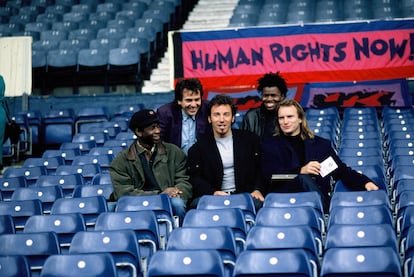

“I have the feeling that Springsteen has always been someone who is sensitive to social issues. I think the fame and scrutiny that this album subjected him to made him more aware of the power and significance of the loudspeaker he had at his disposal because of his status,” says Joana Serrat. “The function of the right wing and hegemonic culture is always to take away the power and meaning of that which is countercultural. I’m not saying Bruce was underground by any means, but his discourse went against the interests of the government and its status quo.”
“Since 2004, Springsteen has become more involved in politics by supporting the Democratic Party, either by participating in the Vote For Change tour or by supporting its candidates, especially Obama,” notes Miguel Martínez, who does not find it strange that the musician wanted to “raise the volume of his voice in that field, if you consider what he had in front of him: Trumpism and beyond. But there is also something inherent to any mass phenomenon: that it becomes a magnet for morons,” adds the critic.
“Born in the U.S.A. is one of the clearest examples of how a lyric can be misinterpreted politically. It is not a patriotic hymn, but a terrible nightmare after Vietnam,” says Ignacio Juliá. “From there, Springsteen has developed a trajectory as a carefully supervised and maintained political figure. I have always criticized The Rising (2002) for telling only a part of 9/11, that of the city attacked and the collective mourning that followed, without showing the political causes that led to the attack, as others did (Steve Earle, Jackson Browne, Patti Smith...). But he has also shown courage: in 2000 he recorded American Skin (41 Shots), about the death of an innocent man at the hands of the New York police and, in Wrecking Ball (2012) he recorded some of the most piercing songs about the crisis caused by Wall Street in 2008.″
But the New Jersey native continues to be misunderstood, as Joan Colet argues. “My own brother, in 1984, asked me how could I like a guy who sang such a patriotic song as Born in the U.S.A. It didn’t help that at that time at his concerts he planted a giant American flag behind the stage and that his headband and long hair reminded him of Rambo. I asked him to read the lyrics of the song and he changed his perspective. That’s the problem; people don’t want to read the song properly, they’re not interested. They fixate on the chorus and give it a meaning.”
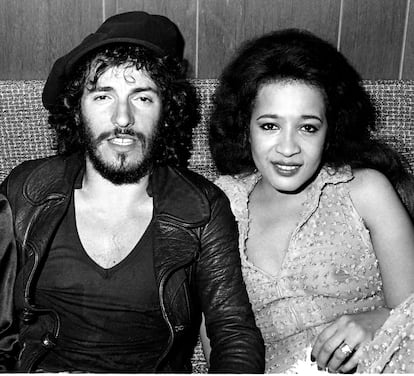

1985: The summer of “Bossmania”
Born in the U.S.A. was also the name of Springsteen’s most ambitious tour. He began by touring all over North America between June 1984 and February 1985, as the popularity of the album was rising. A month later, he flew to Australia and Japan. In June 1985, he arrived in Europe, and that summer, it can be said that Bossmania exploded. A significant fact: his seven albums all entered the bestseller list in the U.K., something that had never happened before with any other artist.
“One of the concessions Bruce had to face was the change of venues,” notes Joan Colet. “He used to be comfortable performing in theaters of 2,000 people or less. On The River tour he had to give way to pavilions because of the demand from his fans. He wasn’t very happy because it wasn’t clear to him that the people in the back row would hear the concert well and feel the power of his show. He became paranoid and sat in the back row at soundchecks to see if they would be able to hear properly. Bruce had always felt the need for the audience, when they went home, to feel as if the concert had been for them alone. He wanted to see all their faces and meet the eyes of all his fans. By 1984, he was still able to control his concerts during the first part of the tour, but then came the madness and chaos in Europe. The first concert was in the Slane Castle esplanade, on the outskirts of Dublin. Only two days before, the Heysel Stadium tragedy had occurred, where 39 Italian fans died at the European Cup final between Liverpool and Juventus. When Bruce saw at Slane Castle the tide of people going from one side to the other, almost without setting foot on the ground, he was so scared that, during the intermission, he told Jon Landau in the dressing room that he was not going to go on stage in for second half and to cancel the entire stadium tour because he did not want to have the burden of conscience of a fan dying at one of his concerts. The manager convinced him that they would take all the safety precautions.”
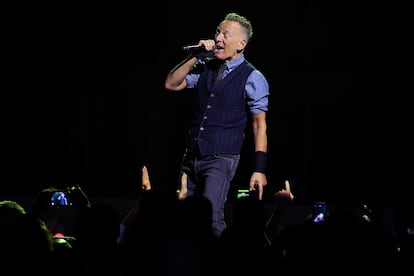
After finishing the 156-concert tour in Los Angeles in October, it was the perfect time to release his first live album. But he opted for something much more ambitious, at the height of that triumphant moment: a box set of five LPs that, with the title Live/1975-85, included live tracks collected throughout that 10-year period. It was the first box set to debut at number one in the U.S. and remains one of the best-selling live albums of all time. There, the Boss hit his ceiling. “He was already the man at the top, he had culminated an ascent of a dozen years and now it was time to ask himself other questions,” says Miguel Martínez. “After Tunnel of Love (1987), the Springsteen of the 1970s gave way to the megastar and that role resulted in a subsequent irregular discography. With a few exceptions, what he did after that was highly criticized and lacking in the old inspiration… even mediocre. Today, Springsteen, like the Stones, AC/DC or U2, is just a nostalgic and sometimes exciting large-stadium spectacle,” concludes Ignacio Juliá.
Sign up for our weekly newsletter to get more English-language news coverage from EL PAÍS USA Edition
Tu suscripción se está usando en otro dispositivo
¿Quieres añadir otro usuario a tu suscripción?
Si continúas leyendo en este dispositivo, no se podrá leer en el otro.
FlechaTu suscripción se está usando en otro dispositivo y solo puedes acceder a EL PAÍS desde un dispositivo a la vez.
Si quieres compartir tu cuenta, cambia tu suscripción a la modalidad Premium, así podrás añadir otro usuario. Cada uno accederá con su propia cuenta de email, lo que os permitirá personalizar vuestra experiencia en EL PAÍS.
¿Tienes una suscripción de empresa? Accede aquí para contratar más cuentas.
En el caso de no saber quién está usando tu cuenta, te recomendamos cambiar tu contraseña aquí.
Si decides continuar compartiendo tu cuenta, este mensaje se mostrará en tu dispositivo y en el de la otra persona que está usando tu cuenta de forma indefinida, afectando a tu experiencia de lectura. Puedes consultar aquí los términos y condiciones de la suscripción digital.
More information
Archived In
Últimas noticias
Alain Aspect, Nobel laureate in physics: ‘Einstein was so smart that he would have had to recognize quantum entanglement’
Imelda Castro, the woman who wants to rule the cartel battleground of Sinaloa
The new victims of the Republican war on Obamacare: Millions hit by soaring health insurance premiums
A country divided on migrant rights: Some US states expand protections while others restrict them
Most viewed
- David King, chemist: ‘There are scientists studying how to cool the planet; nobody should stop these experiments from happening’
- Reinhard Genzel, Nobel laureate in physics: ‘One-minute videos will never give you the truth’
- Oona Chaplin: ‘I told James Cameron that I was living in a treehouse and starting a permaculture project with a friend’
- Sinaloa Cartel war is taking its toll on Los Chapitos
- Mexico completes its trade shift with the entry into force of tariffs on China and countries without trade agreements










































